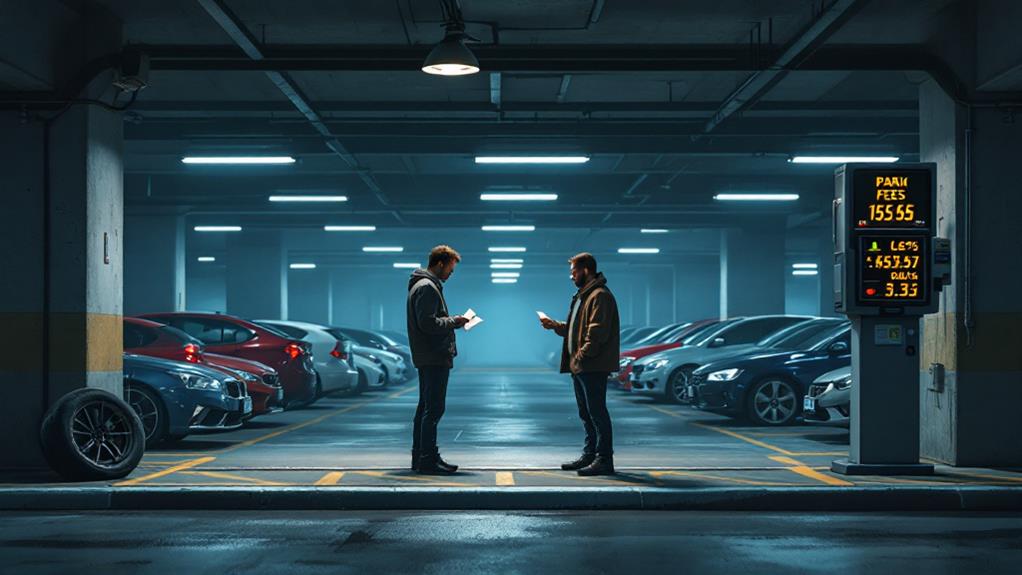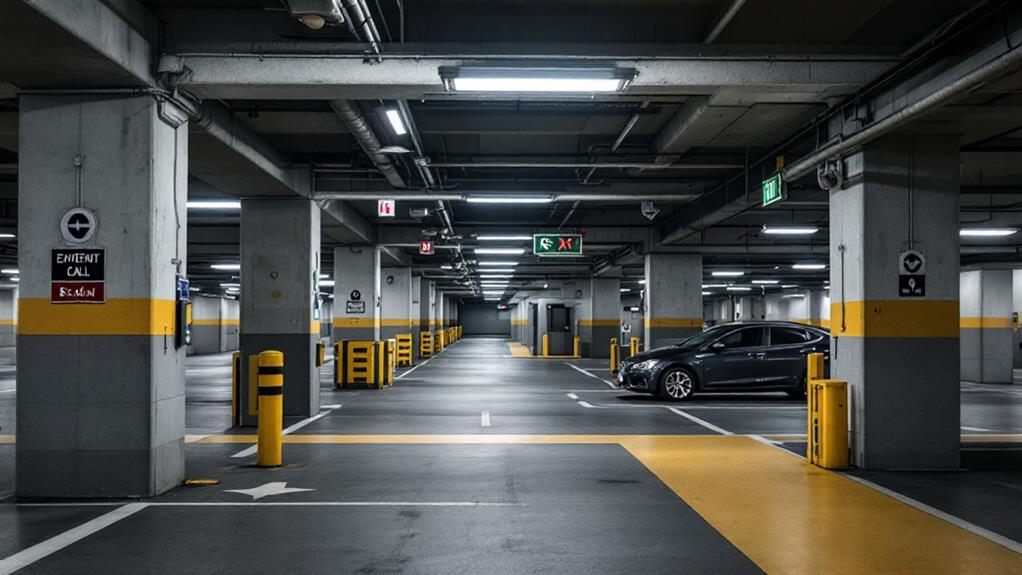The Hidden Costs of Parking in Public Garages

When you park in a public garage, you're paying for more than just a space. Hidden costs include land consumption, construction expenses, and environmental impacts. These structures contribute to urban sprawl, increase traffic congestion, and pose safety risks. You're also subsidizing inefficient parking policies that drive up housing costs and perpetuate inequities. The true price tag extends beyond your ticket, affecting your community's health, economy, and sustainability. As technology reshapes urban mobility, the future of parking is changing rapidly. Understanding these hidden costs can help you make more informed decisions about your transportation choices and support smarter urban planning.
Land Consumption and Opportunity Costs
In the heart of thriving cities, parking garages quietly consume vast tracts of prime real estate. You might not realize it, but these structures occupy some of the most precious land in urban centers, often at a significant cost to your community.
When you park your car in a public garage, you're using up to 400 square feet of space – enough room to build a small apartment. This land consumption comes with hefty opportunity costs, estimated at $50,000 to $100,000 per parking space in major cities. Instead of housing, retail, or other productive uses, these areas are dedicated solely to storing vehicles.
The impact of parking lots extends beyond mere space utilization. They contribute to urban sprawl by reducing density and hindering the development of compact, mixed-use neighborhoods. As you drive into these garages, you're unknowingly participating in a system that prioritizes car storage over human-centric urban design.
Construction costs for parking garages are just the tip of the iceberg. The true expense lies in the lost potential for more beneficial urban development. By recognizing these hidden costs, you can better understand the trade-offs involved in urban planning and parking policies.
Construction and Maintenance Expenses
Concrete and steel aren't the only substantial investments in public parking garages. You might be surprised to learn that the cost of providing a single parking space can range from $15,000 to $50,000, with underground structures being the priciest. But that's just the beginning of the financial commitment.
Once built, these structures demand ongoing attention and resources. You'll find that annual maintenance and operation costs for each parking space can set you back $500 to $1,500. This includes expenses for regular repairs, cleaning, and security. Don't forget about the hefty electricity bills, which can account for up to 30% of a garage's operating costs.
The financial burden doesn't stop there. Parking garages have a relatively short lifespan of 30-50 years, meaning you'll need to plan for eventual replacement. Labor costs for attendants and other staff add another layer of ongoing expenses. When you consider all these factors, it becomes clear that the construction and maintenance of parking garages represent a significant and long-term financial commitment for municipalities, far beyond the initial building costs.
Environmental Impact of Parking Structures

While the financial burden of parking structures is substantial, their environmental impact is equally concerning. You might not realize it, but parking spaces in the United States cover an area larger than 650 square miles, contributing to urban heat islands and increased stormwater runoff. These structures aren't just passive occupants of land; they're active contributors to climate change.
When you park in a garage, you're participating in a system that generates significant greenhouse gas emissions. The construction and maintenance of these structures require enormous amounts of energy and materials. In fact, the embodied carbon emissions from parking garages can account for up to 15% of a typical building's total carbon footprint.
Moreover, the parking supply affects local air quality. Vehicles in these structures emit pollutants like nitrogen oxides and particulate matter. Surface parking and multi-story garages also occupy precious urban land that could be used for more sustainable purposes, such as green spaces or affordable housing. By understanding these hidden environmental costs, you can make more informed decisions about your transportation choices and support initiatives that promote sustainable urban development.
Traffic Congestion and Urban Planning
A lively city's lifeblood is its transportation network, but excessive parking can clog its arteries. When you drive in search of a spot, you're inadvertently contributing to traffic congestion. This problem is exacerbated by outdated parking minimums that encourage sprawling, car-dependent development patterns. These requirements reduce urban density and walkability, forcing you to rely more on your vehicle.
To combat this issue, cities are rethinking their parking policies. By removing or reducing parking requirements, you'll likely see a decrease in vehicle miles traveled and an increase in public transit use, cycling, and walking. Innovative parking management strategies can help optimize supply and mitigate congestion. For instance, shared parking arrangements can maximize the use of existing spaces.
Implementing flexible parking pricing and other forward-thinking policies can discourage private vehicle use and shift your travel behavior towards more sustainable modes. As cities integrate parking with broader transportation planning, you'll experience improved urban mobility and reduced traffic congestion. By embracing these changes, you're contributing to a more efficient, sustainable, and livable urban environment that prioritizes people over cars.
Public Health and Safety Concerns

For years, public parking garages have been a double-edged sword for urban dwellers. While they offer convenient parking solutions, they also harbor hidden dangers that can impact your health and safety. Consider these alarming facts:
- 16% of violent crimes occur in parking garages
- 1 in 5 car thefts happen in parking facilities
- Over 50,000 fall-related injuries occur annually in these structures
When you park in a public garage, you're exposing yourself to various risks. Poorly lit and unattended areas increase your chances of becoming a victim of crime or experiencing vehicle break-ins. The enclosed nature of parking garages also poses health hazards, with carbon monoxide levels up to 10 times higher than outdoor air. This exposure can lead to respiratory issues and other health problems.
Your safety is further compromised by slippery surfaces, inadequate signage, and lack of designated pedestrian paths. These factors contribute to a high number of fall-related injuries and pedestrian accidents. With an estimated 500 pedestrian injuries occurring in parking structures each year, it's essential to remain vigilant and aware of your surroundings when using these facilities.
Economic Inefficiencies of Subsidized Parking
The true cost of parking often remains hidden from view. When you park your car in a public garage, you're likely unaware of the economic inefficiencies created by subsidized parking. Research shows that providing free or subsidized parking in the U.S. costs over $100 billion annually, a burden ultimately shouldered by the public.
City zoning codes often impose parking minimums, leading to an oversupply of parking. Many garages have 20% or more vacant spots during peak hours, representing wasted resources and lost opportunities for more productive land use. The cost of parking in urban areas can reach $50,000 per space to construct, driving up housing costs and limiting development potential.
You might not realize that over 30% of downtown traffic is caused by drivers searching for parking, increasing congestion and emissions. By unbundling the cost of parking from housing and implementing market-based pricing, cities can reduce excess driving and parking demand. This approach generates revenue for public transportation and infrastructure while promoting more efficient use of urban space.
Social Equity Issues in Parking

Beyond economic inefficiencies, parking policies often create or exacerbate social inequities. You might not realize it, but the hidden costs of parking in public garages disproportionately affect vulnerable populations. Low-income residents, for instance, often spend a larger share of their income on parking fees, further straining their already tight budgets and compromising their ability to afford housing and other essentials.
Consider these often-overlooked impacts:
- Elderly and disabled individuals face reduced mobility due to parking challenges
- Marginalized communities encounter barriers to accessing jobs and healthcare
- Disadvantaged neighborhoods lose out on indispensable land that could be used for community amenities
You'll find that parking costs can create a significant obstacle for those trying to access essential services or job opportunities. Meanwhile, free or discounted parking programs tend to benefit higher-income individuals, perpetuating existing inequities. The land dedicated to parking in urban areas often comes at the expense of green spaces and other community resources, particularly in disadvantaged neighborhoods. As you consider the true cost of parking, it's important to recognize these social equity issues and work towards more inclusive and fair parking policies.
Technological Disruption and Future Trends
With technological advancements reshaping urban mobility, you're likely to see significant changes in how parking garages operate and even exist in the future. Autonomous vehicles are poised prepared to revolutionize the parking landscape, potentially reducing the need for spaces in prime locations as self-driving cars can park themselves further away from activity centers.
You'll also notice the impact of shared mobility services on parking demand. As ride-hailing and car-sharing options become more prevalent, fewer people are opting for personal vehicle ownership, especially in urban areas. This shift is already decreasing the need for extensive parking infrastructure.
Digital parking technologies are transforming converting how you interact with parking facilities. Mobile apps and dynamic fluid pricing systems are improving management efficiency and reducing the need for overbuilt parking structures. You might find yourself using integrated mobility hubs that combine parking with other transportation modes, offering a more streamlined approach to urban mobility.
As these trends continue, you'll likely see more repurposing of existing parking garages. Urban farming, mixed-use developments, and other innovative uses are becoming increasingly common as cities adapt to changing transportation patterns and seek to maximize valuable significant urban space.



